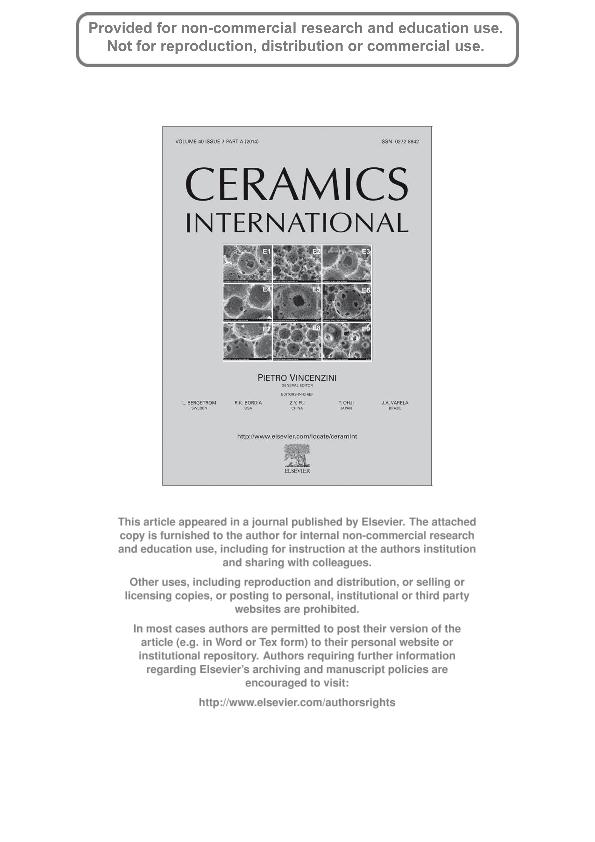Mostrar el registro sencillo del ítem
dc.contributor.author
Muñoz, Vanesa

dc.contributor.author
Pena, Pilar
dc.contributor.author
Tomba Martinez, Analia Gladys

dc.date.available
2017-10-06T18:48:52Z
dc.date.issued
2014-01
dc.identifier.citation
Muñoz, Vanesa; Pena, Pilar; Tomba Martinez, Analia Gladys; Physical, chemical and thermal characterization of alumina–magnesia–carbon refractories; Elsevier; Ceramics International; 40; 7A; 1-2014; 9133-9149
dc.identifier.issn
0272-8842
dc.identifier.uri
http://hdl.handle.net/11336/26130
dc.description.abstract
Alumina–magnesia–carbon refractories (AMC) are of great technological interest for their use as linings for iron and steelmaking ladles. In this paper, the methodology implemented for the physical, chemical and thermal characterization of AMC refractories is presented along with the obtained results. These results are essential for the study of the chemical and mechanical behavior of these materials, which the present work frames. AMC bricks comprise different amounts of alumina, sintered or electrofused magnesia, graphite and antioxidant additives bonded together with a phenolic resin. The variety of components, be they oxidic, metallic or polymeric in nature, and the complexity of the final microstructure and texture make characterizing these refractories a difficult task. In the present work, several complementary techniques were used in combination: X-ray fluorescence, plasma emission spectroscopy, gravimetry, X-ray diffraction, differential thermal and thermogrametric analyses, reflection optical microscopy and scanning electron microscopy, density and porosity measurements, dilatometric analysis and permanent linear change measurements. The results of these different techniques were analyzed separately and together in order to obtain a detailed description of each refractory in relation to its physical and chemical characteristics and thermal evolution. In addition, the characterization was completed by evaluating the mechanical properties at room temperature, such as the mechanical strength and Young's modulus.
dc.format
application/pdf
dc.language.iso
eng
dc.publisher
Elsevier

dc.rights
info:eu-repo/semantics/openAccess
dc.rights.uri
https://creativecommons.org/licenses/by-nc-sa/2.5/ar/
dc.subject
Microstructure-Final
dc.subject
Mechanical Properties
dc.subject
Al2o3
dc.subject
Refractories
dc.subject
Mgo
dc.subject
Carbon
dc.subject.classification
Compuestos

dc.subject.classification
Ingeniería de los Materiales

dc.subject.classification
INGENIERÍAS Y TECNOLOGÍAS

dc.title
Physical, chemical and thermal characterization of alumina–magnesia–carbon refractories
dc.type
info:eu-repo/semantics/article
dc.type
info:ar-repo/semantics/artículo
dc.type
info:eu-repo/semantics/publishedVersion
dc.date.updated
2017-09-01T18:42:39Z
dc.journal.volume
40
dc.journal.number
7A
dc.journal.pagination
9133-9149
dc.journal.pais
Países Bajos

dc.journal.ciudad
Amsterdam
dc.description.fil
Fil: Muñoz, Vanesa. Consejo Nacional de Investigaciones Científicas y Técnicas. Centro Científico Tecnológico Conicet - Mar del Plata. Instituto de Investigaciones en Ciencia y Tecnología de Materiales. Universidad Nacional de Mar del Plata. Facultad de Ingeniería. Instituto de Investigaciones en Ciencia y Tecnología de Materiales; Argentina
dc.description.fil
Fil: Pena, Pilar. Instituto de Ceramica y Vidrio de Madrid; España
dc.description.fil
Fil: Tomba Martinez, Analia Gladys. Consejo Nacional de Investigaciones Científicas y Técnicas. Centro Científico Tecnológico Conicet - Mar del Plata. Instituto de Investigaciones en Ciencia y Tecnología de Materiales. Universidad Nacional de Mar del Plata. Facultad de Ingeniería. Instituto de Investigaciones en Ciencia y Tecnología de Materiales; Argentina
dc.journal.title
Ceramics International

dc.relation.alternativeid
info:eu-repo/semantics/altIdentifier/url/http://www.sciencedirect.com/science/article/pii/S0272884214001552
dc.relation.alternativeid
info:eu-repo/semantics/altIdentifier/doi/http://dx.doi.org/10.1016/j.ceramint.2014.01.128
Archivos asociados
